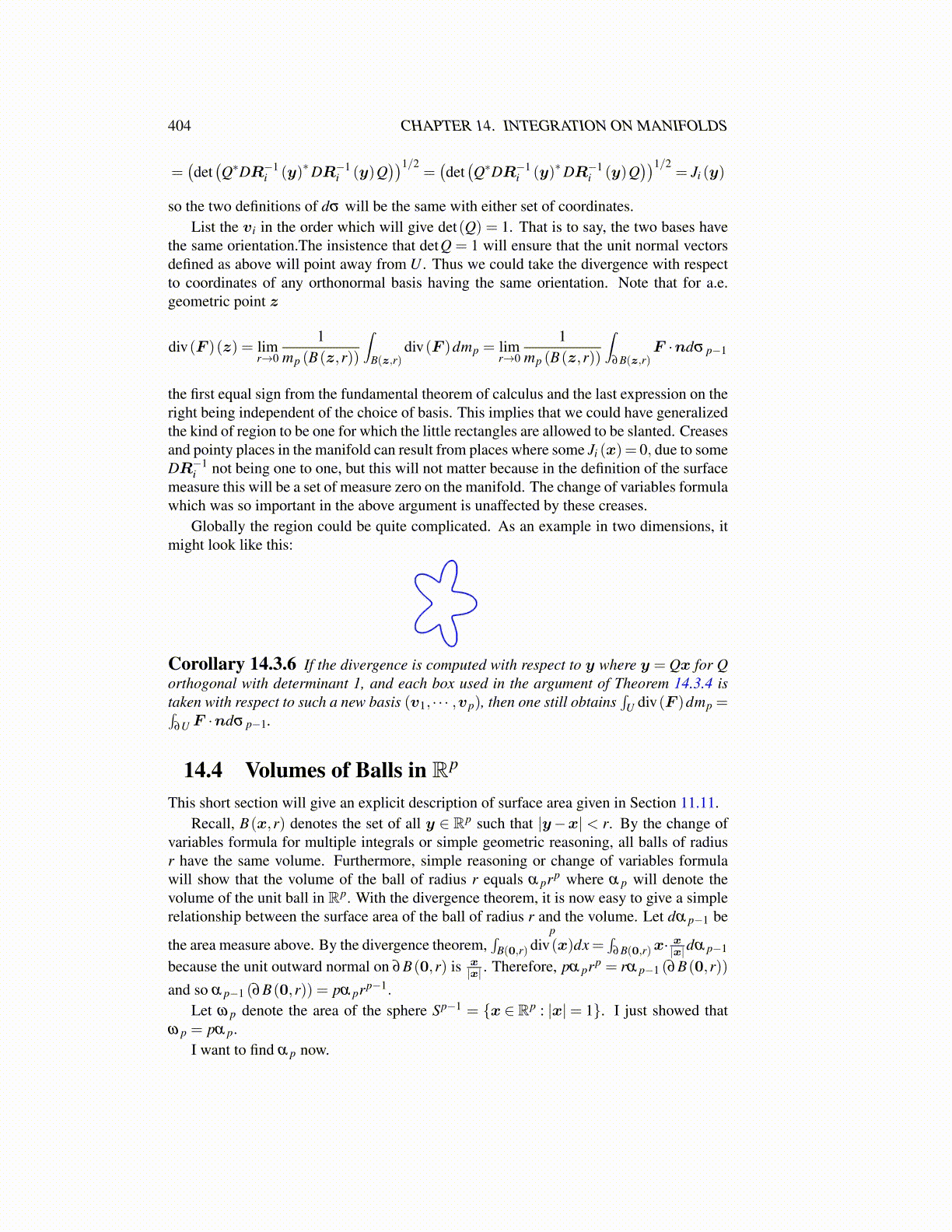
404 CHAPTER 14. INTEGRATION ON MANIFOLDS
=(det(Q∗DR−1
i (y)∗DR−1i (y)Q
))1/2=(det(Q∗DR−1
i (y)∗DR−1i (y)Q
))1/2= Ji (y)
so the two definitions of dσ will be the same with either set of coordinates.List the vi in the order which will give det(Q) = 1. That is to say, the two bases have
the same orientation.The insistence that detQ = 1 will ensure that the unit normal vectorsdefined as above will point away from U . Thus we could take the divergence with respectto coordinates of any orthonormal basis having the same orientation. Note that for a.e.geometric point z
div(F )(z) = limr→0
1mp (B(z,r))
∫B(z,r)
div(F )dmp = limr→0
1mp (B(z,r))
∫∂B(z,r)
F ·ndσ p−1
the first equal sign from the fundamental theorem of calculus and the last expression on theright being independent of the choice of basis. This implies that we could have generalizedthe kind of region to be one for which the little rectangles are allowed to be slanted. Creasesand pointy places in the manifold can result from places where some Ji (x)= 0, due to someDR−1
i not being one to one, but this will not matter because in the definition of the surfacemeasure this will be a set of measure zero on the manifold. The change of variables formulawhich was so important in the above argument is unaffected by these creases.
Globally the region could be quite complicated. As an example in two dimensions, itmight look like this:
Corollary 14.3.6 If the divergence is computed with respect to y where y = Qx for Qorthogonal with determinant 1, and each box used in the argument of Theorem 14.3.4 istaken with respect to such a new basis (v1, · · · ,vp), then one still obtains
∫U div(F )dmp =∫
∂U F ·ndσ p−1.
14.4 Volumes of Balls in Rp
This short section will give an explicit description of surface area given in Section 11.11.Recall, B(x,r) denotes the set of all y ∈ Rp such that |y−x| < r. By the change of
variables formula for multiple integrals or simple geometric reasoning, all balls of radiusr have the same volume. Furthermore, simple reasoning or change of variables formulawill show that the volume of the ball of radius r equals α prp where α p will denote thevolume of the unit ball in Rp. With the divergence theorem, it is now easy to give a simplerelationship between the surface area of the ball of radius r and the volume. Let dα p−1 be
the area measure above. By the divergence theorem,∫
B(0,r)
pdiv(x)dx=
∫∂B(0,r)x· x|x|dα p−1
because the unit outward normal on ∂B(0,r) is x|x| . Therefore, pα prp = rα p−1 (∂B(0,r))
and so α p−1 (∂B(0,r)) = pα prp−1.
Let ω p denote the area of the sphere Sp−1 = {x ∈ Rp : |x|= 1}. I just showed thatω p = pα p.
I want to find α p now.